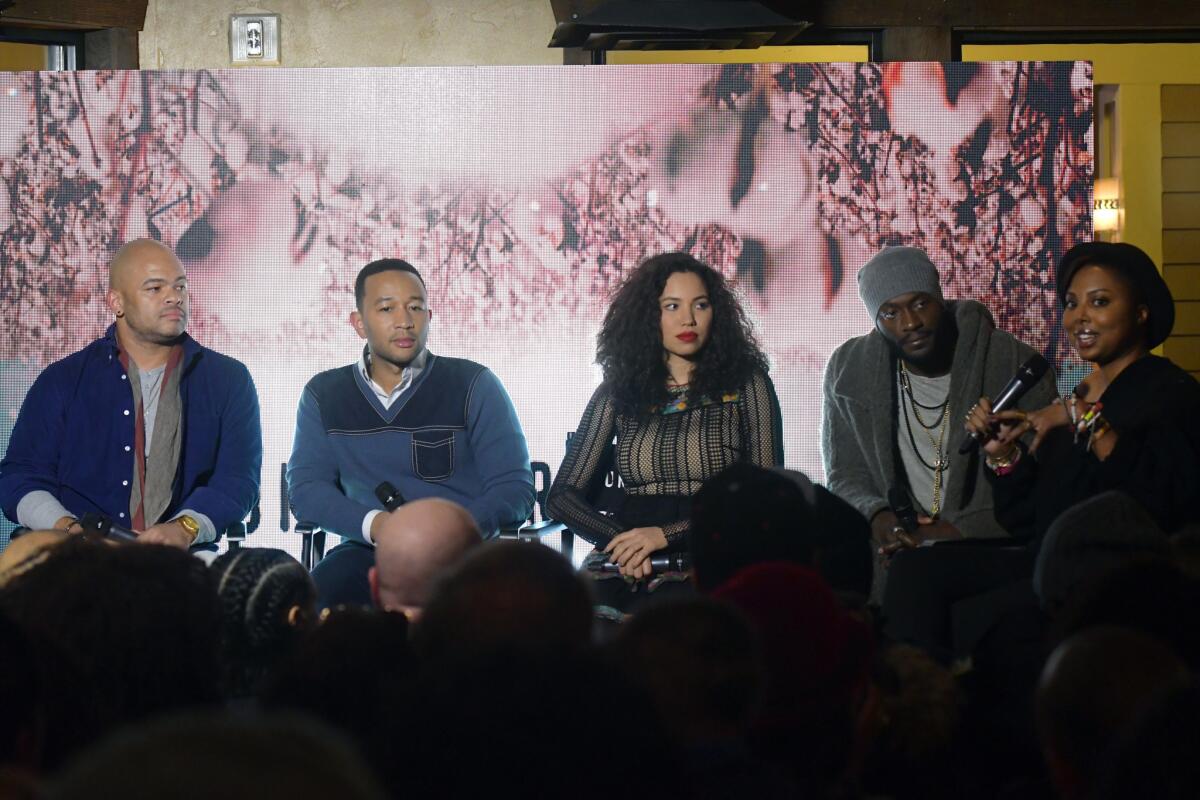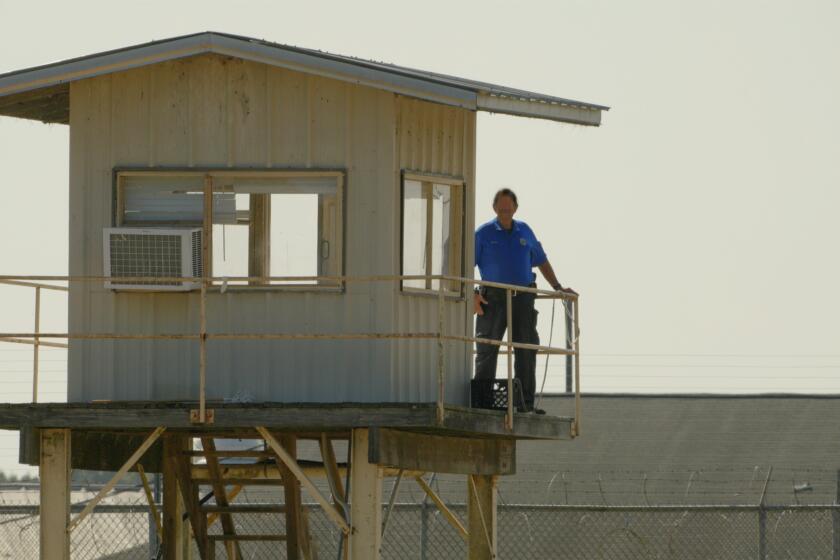A filmmaker of color’s secret weapon at Sundance? Diversity lounges
- Share via
PARK CITY, Utah — This year’s Sundance was the blackest in the festival’s 35-year history. Or at least that’s what it felt like, according to countless movie lovers who descended on Park City for the annual gathering of indie film.
The festival had more than 55 movies programmed that were written, directed or led by black talent, including Eugene Ashe’s period romance “Sylvie’s Love” with Tessa Thompson and Nnamdi Asomugha, Justin Simien’s ’80s horror throwback “Bad Hair” and Janicza Bravo’s “Zola” with a breakout Taylour Paige — almost guaranteeing that Brickson Diamond wouldn’t experience what he had his first few times at Sundance.
“There was a time where if you saw a black person, you stopped them and you wouldn’t let them go,” recalled the cofounder and board chair of the Blackhouse Foundation. “You’d say, ‘Hey, good to see you. What are we doing tonight? I’m not going to let you out of my sight because I’ll never see you again.’”
There weren’t a lot of black people on the mountain, so when they saw each other, looking like a fly in buttermilk, they stuck together. “Now you can give the polite [head] nod when you pass by because you know there will be eight more black people to come,” Diamond added.
Part of the credit for his anecdotal observation goes to the fest’s film slate, which has increasingly made room for more pictures by and about people of color. A nod, however, must also be given to the countless lounges, lodges and houses launched over the years to provide safe spaces for creatives to commune, including the Blackhouse and Macro Lodge. As havens for Sundance’s communities of color, their continued presence is just one answer to ongoing calls for industry inclusion.
Their prototype during the festival was the now-defunct Queer Lounge. Founded by former film executive Ellen Huang, the Queer Lounge launched in the early 2000s as a hospitality and event space for LGBTQ+ people attending the fest. While anyone of any sexual orientation or gender identity was welcome, it uplifted the queer films playing in the festival and provided a gathering place for folks to network, access Wi-Fi and recharge before venturing back out into the snowy Sundance streets.
Diamond found himself in the Queer Lounge during Sundance 2006, along with Ryan Tarpley, the former chief diversity officer at CAA, and the two were approached by noted producer Carol Ann Shine, who has worked on a number of black LGBTQ+ television shows and films, including Patrik-Ian Polk’s “Punks” and “Noah’s Arc.”
“She was like, ‘We should do this Queer Lounge for black people,’” Diamond said. That September, the trio cofounded the Blackhouse Foundation as a way to address their frustration at seeing so few people of color reflected in the attendance and on the films selected for the festival. That first year, in 2007, as an official partner of the Sundance Institute, they hosted a series of panels, round-table discussions and networking events, with their first big party being for Our Stories Film, the studio founded by BET cofounder Bob Johnson and headed by Tracey Edmonds.
“There was a line around the block,” Diamond said. “We had Eddie Murphy, who was fresh off his Oscar nomination for ‘Dreamgirls.’ Nelly showed up with his tour bus in Park City asking where he could park it. ‘Diddy’ [Sean Combs] came in after him. Three 6 Mafia was there, and they had won their Oscar for ‘It’s Hard Out Here for a Pimp’ the year before. Timothy Hutton was there somehow…
“Just this notion of putting out the call and saying, ‘We’re going to create a space’ — [Sundance] was instantly transformed.”
Suddenly, there was not only a hub for all things black at the festival but also a place that over the years has come to assist black creatives with submitting their movies to Sundance, navigating filmmaker labs and learning the financing side of the business, among other skills.
In the 13 years since the Blackhouse has had a presence at the festival — they took off 2009, Diamond said, because of the recession and because “everybody black was in D.C.” for the inauguration of President Obama — a number of other safe spaces for festival attendees of color have sprouted up, perhaps most notably the Macro Lodge.

Spearheaded by Charles D. King’s production company of the same name, which celebrated its launch at the Blackhouse at the festival five years ago, the Macro Lodge has become one of the hottest tickets of Sundance for anyone of color. According to Stacey Walker King, the company’s chief brand officer (and King’s wife), the idea grew out of both their mission to be an authoritative media brand representing the voices and perspectives of people of color and wanting a place to grab coffee in between films at the fest.
“I wanted it to be a place where you could come and do all of the things: charge your phone, get warm, meet up with someone you didn’t even know was here,” she said. “I wanted people to be able to have those serendipitous moments [and be a] place for POC creatives, executives, festivalgoers to have that moment on this mountain.”
This year, the Macro Lodge’s third, the company’s fifth anniversary was celebrated with panel discussions, conversations and other events featuring Thompson, Simien, Lena Waithe, Issa Rae, America Ferrera, Daniel Dae Kim, Kenya Barris, Dee Rees, Stella Meghie, the Sundance Institute’s Bird Runningwater and Matthew A. Cherry, director of the Oscar-nominated animated short “Hair Love,” among others — many of which were livestreamed for social media audiences and those who couldn’t make it inside the Lodge because of capacity restrictions.
While the Blackhouse and the Macro Lodge are evidence enough of a diversity sea change at Sundance, so too are other pop-ups catering to marginalized groups. This year marked the first that the LatinX House, created by activist Mónica Ramírez, producer Olga Segura and writer Alex Martinez Kondracke, had a presence at Sundance.
It was also the first time that Outfest, Los Angeles’ leading LGBTQ film festival, sponsored a day-long Outfest House uplifitng queer and trans filmmakers. For the 16th year, the Asian Pacific Filmmakers Experience took place, highlighting Asian Pacific American and Asian international artists.
“What I see that’s different [than when I first started coming to Sundance] is that there’s enough of us here that we can have a packed out panel in our space and I’m able to dip out to Blackhouse and he’s got a packed out room,” Stacey Walker King said. “And then I can pop over to the Latinx House and they’ve got a packed out room too. So I think just sheer numbers have exponentially increased.”
Diamond’s eyes remain on the broader industry experience for folks of color. It’s a necessary focus on the heels of continued calls for greater diversity, equity and inclusion writ large after a rebirth of #OscarsSoWhite this year, following a single Academy Award nomination in the acting categories of a person of color (Cynthia Erivo for “Harriet”).
“Don’t get it crooked,” he said. “We are here to create a safe space for creators to build their sustenance and then get out on those streets and dominate this place and this industry. It’s not about us just sitting inside our own rooms. I want you to come to Blackhouse or Macro or Latinx House or wherever and be emboldened and empowered to go out and kill that mountain.
“It’s about strategizing how are we going to go out and get in those other rooms, which is important for not just the culture, but for the health and diversity of the world. The vision is always to get us everywhere in a space, not just in ours.”
More to Read
Only good movies
Get the Indie Focus newsletter, Mark Olsen's weekly guide to the world of cinema.
You may occasionally receive promotional content from the Los Angeles Times.









